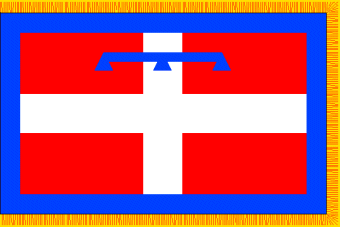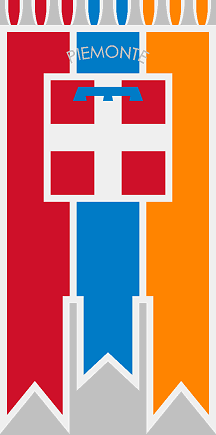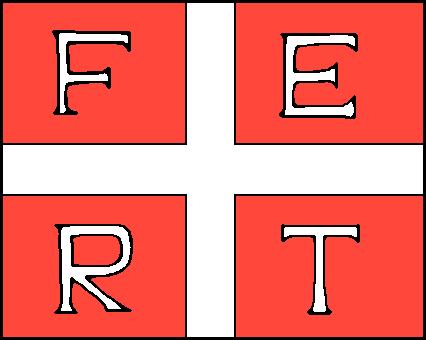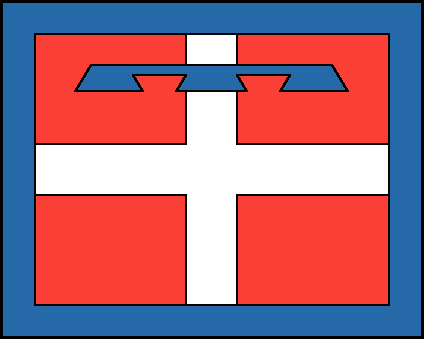 image by Roberto Breschi from CISV
image by Roberto Breschi from CISV
Last modified: 2020-07-17 by rob raeside
Keywords: italy | piedmont | piemonte | savoia |
Links: FOTW homepage |
search |
disclaimer and copyright |
write us |
mirrors
 image by Roberto Breschi from CISV
image by Roberto Breschi from CISV
See:
See also:
Other Sites:
The gonfalon and the coat of arms were adopted on the 16th
January 1984. The coat of arms has a square shape. It is gules a
cross argent a label azure. The gonfalon is vertically
red-blue-orange with the coat of arms in the middle and the words
Regione Piemonte under. These colors are the colors of
the Republic of Alba which was proclaimed on the 25th of April
1796. The official flag of the region adopted on the 24th
November 1995 is red bordered white (thin) and blue with a white
cross charged on top with a blue label. The region adopted on
the 17th June 1997 a law regulating the use of this flag.
Pascal Vagnat, 22 September 1998
The flag of Piedmont is the coat of arms of the Prince of Piedmont, the title traditionally attributed to the eldest son of the King of Sardinia. It consists of the coat of arms of the Savory family with an azure label on it.
Francois Velde, 12 April 1996
The official Piemonte's regional flag was adopted circa
26 October 1995 and also has thin white (inner) and blue
(outer) borders on all sides.
Mario Fabretto, 20 September 1996
I have attached an image of that flag, with the official
colours and proportions. The flag is red with a white cross and a
superimposed blue label, the whole is surrounded by a blue
border and the flag itself is golden fringed. Depending on the
context the flag may be fringed on the top, bottom and fly (like
here). In that case there is an orange ribbon attached at the
hoist. Orange-blue-red are the colours of the gonfanon of the
Region. In other cases, like the flag on a balcony, there is a
fringe on the hoist side, on the fly and on the bottom of the
flag. If other cases the flag is entirely fringed. The official
colours are blue 3005 and red 185. (These colours seem quite
light for me, either on the screen as on the paper when printed.)
Source: Regional Council of Piedmont.
Pascal Vagnat, 12 May 1999
In Piedmont, the law says the regional flag has to fly
together with the national flag and the EU flag in a number of
occasion (e.g. when a town council or the regional parliament is
meeting).
Silvio Sandrone, 20 October 1999
There are two versions of that flag: one with a blue border,
and one without a blue border. That last version was adopted
officially in 1995, with a gold fringe and an orange ribbon.
Pascal Vagnat, 20 October 1999
The regional flag of Piedmont is hoisted over the buildings of
the Faculty of Sciences of the University of Turin, located in Grugliasco, a town neighbouring Turin,
along with the flags of European Union and Italy (as seen in
January 2005). The regional flag used there has no golden fringe
at all. The region Piedmont uses a logo made of a square version
of the flag, without the fringe, too.
Ivan Sache, 17 January 2008
The stemma first appeared in 1143 when it was used as a seal of Amadeus III (1103-1148). The blue label, heraldic sign of primogeniture, was added to it in 1424 by Amadeus VIII (1383-1451) when he used to invest his eldest son Amadeus with the title of Prince of Piedmont: https://it.wikipedia.org/wiki/Simboli_del_Piemonte#/media/File:Regione-Piemonte-Stemma.svg. The flag of Piedmont as we know it today was legally adopted in 1995 and it has two forms: https://it.wikipedia.org/wiki/Piemonte#/media/File:Piemonte_Bandiera.png (official) and https://it.wikipedia.org/wiki/Simboli_del_Piemonte#/media/File:Flag_of_Piedmont.svg (alternate).
Officially, in a regional law from 1995 the flag is described as having “golden fringes” (see below). I also saw a document that shows the dimensions and proportions for the flag which also includes the fringes. I suspect that the fringes are an unintended introduction so the version of the flag that I call “alternate” is pretty much the standard and the fringes are an embellishment for special, ceremonial and official occasions.
As of now, late June 2020, Piedmont formulated 5 regional laws between 1984 and 2007 which describe the symbols of Piedmont and 4 of them specifically relate to the flag with the first dating to 1995.
The following 4 regional laws, all in the original text in Italian, formalize the symbols of Piedmont and establish specific aspects of the flag of the region:
 image by Mello Luchtenberg, 14 September 2001
image by Mello Luchtenberg, 14 September 2001
Based on a drawing at
www.italonet.com.br.
Mello Luchtenberg, 14 September 2001
The story of the Piedmontese flag ("ël drapò") is strictly
related to Savoia dynasty.
The glorious drapò could derive from the war-flag of Holy Roman
Empire or from Pietro I who abandoned his coat of arms (an Imperial Eagle)
and adopted a flag similar to the English one, due to his
permanence in that country as Duke of Richmond (1241). In fact
between 1188 and 1277 the English Kingdom used a red flag with a cross argent.
From 1263 that flag was always used by Savoia, in some variants.
It was officially adopted by Amedeo V, Conte of Savoia from
1285. It seems that its first use was in 1310 in Turin in occasion
of the meeting between Amedeo V and his cousin Emperor Arrigo
VII.
 image by Matteo Colaone, 24 August 2000
image by Matteo Colaone, 24 August 2000
In order to distinguish the Savoia-Piemonte flag in the Mediterranean
Sea from the Maltese one, were added the letters F.E.R.T. in white. I
suppose it stands for: "FORTITUDO EIUS RHODUM TENUIT",
(referred to Amedeo V in 1310) or otherwise "FOEDERE
ET RELIGIONE TENEMUR".
Matteo Colaone, 24 August 2000
 image by Matteo Colaone, 24 August 2000
image by Matteo Colaone, 24 August 2000
Probably, in 1366, a blue border was added in honour of Maria, the mother of Jesus. This is also part of the flag of the Kingdom of Sardinia (1848-1851). The blue
"Lambello" (="label") with three
"pendenti" was added in 1418 for a heraldic cause (it
indicated that Savoia were Princes of Piedmont).
Matteo Colaone, 24 August 2000
In today's tourism section of the daily newspaper "Yediot
Akhronot" there is a photo of a Piedmont towns
(probably Casale Monferrato) from which we can see that they are
using a simpler variant of
Piedmont flag (white St. George's cross on red).
Dov Gutterman, 30 September 1999